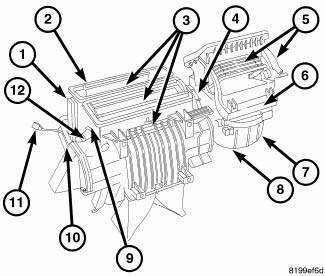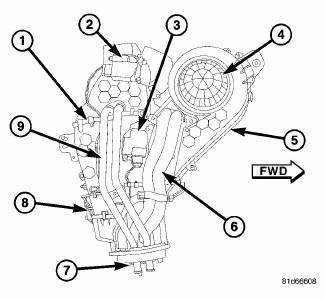Dodge Journey: Description
A manual temperature control (MTC) single zone heating-A/C system, automatic temperature controlled (ATC) dual zone heating-A/C system, MTC tri-zone heating-A/C system and an ATC tri-zone heating-A/C system is available on this vehicle.
To maintain the performance level of the heating, ventilation and air conditioning (HVAC) system, the engine cooling system must be properly maintained. The use of a bug screen is not recommended. Any obstructions in front of the radiator or A/C condenser will reduce the performance of the A/C and engine cooling systems.
The engine cooling system includes the radiator, thermostat, radiator hoses and the engine coolant pump. Refer to COOLING for more information before opening or attempting any service to the engine cooling system.
FRONT HEATING AND A/C SYSTEM

Fig. 1: HVAC Housing
NOTE: Single zone HVAC shown. Dual zone similar.
All vehicles are equipped with a common front heater, ventilation and air conditioning (HVAC) housing (1).
The heating-A/C system combines A/C, heating, and ventilating capabilities in a single HVAC housing mounted within the passenger compartment beneath the instrument panel. The HVAC housing includes:
- A/C evaporator (2)
- Mode-air doors (3)
- Mode door actuator (4)
- Recirculation-air door and actuator (5)
- Particulate air filter (when equipped) (6)
- Blower motor (7)
- Blower motor resistor or power module (depending on system application) (8)
- Blend door actuator(s) (9)
- Heater core (10)
- Evaporator temperature sensor (11)
- Blend-air door(s) (12)
NOTE: An electric positive temperature coefficient (PTC) heater is used on vehicles when equipped with the 2.0L diesel engine. The PTC heater unit compensates for the lower engine coolant temperatures produced by the diesel engine. The PTC heater unit is mounted in the HVAC air distribution housing, downstream of the heater core.
Based upon the system mode selected, conditioned air can exit the front HVAC housing through one or a combination of the three main housing outlets: defrost, panel or floor. The defrost and panel outlets are located on the top of the HVAC air distribution housing and the floor outlets are located on each side of the distribution housing. Once the conditioned air exits the HVAC housing, it is further directed through molded plastic ducts to the various outlets within the vehicle interior. These outlets and their locations are as follows:
- Defroster Outlet - Two defroster outlets are located in the center of the instrument panel, near the base of the windshield.
- Side Window Demister Outlets - There are two side window demister outlets, one is located at each outboard end of the instrument panel, near the A-pillars.
- Panel Outlets - There are four panel outlets in the instrument panel, one located near each outboard end of the instrument panel facing the rear of the vehicle and two located near the top of the instrument panel center bezel.
- Front Floor Outlets - There are two front floor outlets, one located on each side the floor panel center tunnel behind the instrument panel.
- Rear Seat Floor Outlets - There are two rear seat floor outlets, one located on each side of the floor panel near the front of each rear seat foot well.
REAR HEATING AND A/C SYSTEM

Fig. 2: Rear Heater AC Housing Description
The tr-zone heating-A/C systems are equipped with a rear heater-A/C housing (1) that combines A/C and heating capabilities into a single unit mounted within the passenger compartment behind the right quarter interior trim panel. The rear heater-A/C housing includes:
- Mode door and actuator (2)
- Blend door and actuator (3)
- Blower motor (4)
- Blower motor resistor or power module (5) (depending on control system)
- A/C evaporator (6)
- A/C expansion valve (7)
- Wire harness (8)
- Heater core (9)
Based upon the rear temperature selected, conditioned air can exit the rear heater-A/C housing through one or a combination of the two rear housing outlets: ceiling or floor. The ceiling outlet is located at the top rear of the housing and the floor outlet is located at the top front of the rear housing. Once the conditioned air exits the rear heater-A/C housing, it is further directed through molded plastic ducts to the outlets at the rear of the passenger compartment. These outlets and their locations are as follows:
- Ceiling Outlets - There are four ceiling outlets in the headliner. One located at each outboard side of the intermediate seat position and one located in front of each rear seat position.
- Floor Outlet - There is one floor outlet in the right quarter interior trim panel located behind the right rear door area.
 Operation
Operation
The standard front and available rear heating-A/C systems used in this
vehicle are blend-air type systems. In a
blend-air system, a blend-air door controls the amount of conditioned air that
is a ...
See also:
Standard procedure, Cleaning, Inspection
Standard procedure
BATTERY RECONNECTION
NOTE: This reconnection procedure is to be performed anytime the
battery has been
disconnected.
1. Connect the negative battery cable remote termin ...
Holding clutches
DESCRIPTION
Fig. 356: Identifying 2/4 & Low/Reverse Clutches & Planetary Geartrain
Components
- FRONT PLANET CARRIER/REAR ANNULUS
- 2/4 CLUTCH
- L/R CLUTCH
- REAR PLANET CARRIER ...
Diagnosis and Testing
BRAKE LAMP SWITCH
WARNING: To avoid serious or fatal injury on vehicles equipped
with airbags, disable
the Supplemental Restraint System (SRS) before attempting any steering
wheel, s ...

